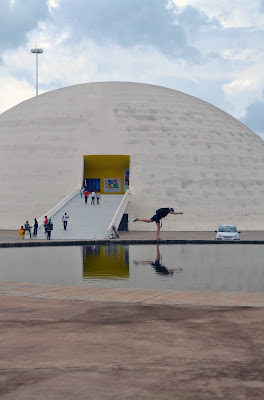Welcome to Brasilia, a constructed Utopia, a "Utopia that was obviously doomed." (Madaleno, 278)
This photo of Brasilia's inaguration portrays Neimeyer's grand vision for the city. As a student described it, being in Brasilia is like living in Neimeyer's Sim City.
The most prominent monument in all of Brasilia, the National Congress Building. We are told that people work there, but saw no sign of it...
Finally a photo from Brasilia with people in it!
Icons weren't limited to buildings.
The National Museum (guess the architect!) brought out the inner Warrior in everyone.
Neimeyer conceptualized the plan of Brasilia as a plane (or bird, or butterfly...). This initial sketch was displayed in the National Museum.
Some of us took a trip out to the University. A surprise rain storm kept us from returning to our hotel, but created beautiful curtain of mist under the walkway.
A few students got an exclusive peek at the new World Cup staduim cup being built. The rendering was very Brasilia, with a population of clones for fans.
Students always have Bozeman in mind. GO MSU!!!

























































